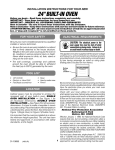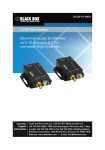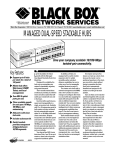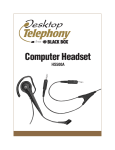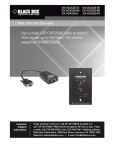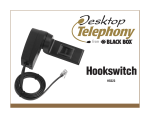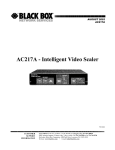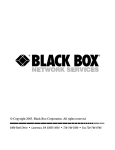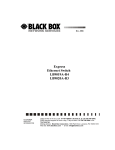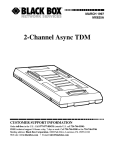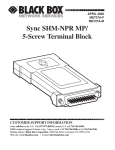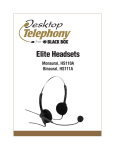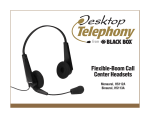Download RJ-11 Data Broadcast Unit
Transcript
APRIL 1999 TL159A TL159AE RJ-11 Data Broadcast Unit DB-8 PWR CH7 CH8 CH5 CH6 H3 CH4 C 2 H C 1 COMP CH CUSTOMER SUPPORT INFORMATION Order toll-free in the U.S. 24 hours, 7 A.M. Monday to midnight Friday: 877-877-BBOX FREE technical support, 24 hours a day, 7 days a week: Call 724-746-5500 or fax 724-746-0746 Mail order: Black Box Corporation, 1000 Park Drive, Lawrence, PA 15055-1018 Web site: www.blackbox.com • E-mail: [email protected] RJ-11 DATA BROADCAST UNIT FEDERAL COMMUNICATIONS COMMISSION AND INDUSTRY CANADA RADIO FREQUENCY INTERFERENCE STATEMENTS This equipment generates, uses, and can radiate radio frequency energy and if not installed and used properly, that is, in strict accordance with the manufacturer’s instructions, may cause interference to radio communication. It has been tested and found to comply with the limits for a Class A computing device in accordance with the specifications in Subpart J of Part 15 of FCC rules, which are designed to provide reasonable protection against such interference when the equipment is operated in a commercial environment. Operation of this equipment in a residential area is likely to cause interference, in which case the user at his own expense will be required to take whatever measures may be necessary to correct the interference. Changes or modifications not expressly approved by the party responsible for compliance could void the user’s authority to operate the equipment. This digital apparatus does not exceed the Class A limits for radio noise emission from digital apparatus set out in the Radio Interference Regulation of Industry Canada. Le présent appareil numérique n’émet pas de bruits radioélectriques dépassant les limites applicables aux appareils numériques de la classe A prescrites dans le Règlement sur le brouillage radioélectrique publié par Industrie Canada. 1 RJ-11 DATA BROADCAST UNIT NORMAS OFICIALES MEXICANAS (NOM) ELECTRICAL SAFETY STATEMENT INSTRUCCIONES DE SEGURIDAD 1. Todas las instrucciones de seguridad y operación deberán ser leídas antes de que el aparato eléctrico sea operado. 2. Las instrucciones de seguridad y operación deberán ser guardadas para referencia futura. 3. Todas las advertencias en el aparato eléctrico y en sus instrucciones de operación deben ser respetadas. 4. Todas las instrucciones de operación y uso deben ser seguidas. 5. El aparato eléctrico no deberá ser usado cerca del agua—por ejemplo, cerca de la tina de baño, lavabo, sótano mojado o cerca de una alberca, etc.. 6. El aparato eléctrico debe ser usado únicamente con carritos o pedestales que sean recomendados por el fabricante. 7. El aparato eléctrico debe ser montado a la pared o al techo sólo como sea recomendado por el fabricante. 8. Servicio—El usuario no debe intentar dar servicio al equipo eléctrico más allá a lo descrito en las instrucciones de operación. Todo otro servicio deberá ser referido a personal de servicio calificado. 9. El aparato eléctrico debe ser situado de tal manera que su posición no interfiera su uso. La colocación del aparato eléctrico sobre una cama, sofá, alfombra o superficie similar puede bloquea la ventilación, no se debe colocar en libreros o gabinetes que impidan el flujo de aire por los orificios de ventilación. 10. El equipo eléctrico deber ser situado fuera del alcance de fuentes de calor como radiadores, registros de calor, estufas u otros aparatos (incluyendo amplificadores) que producen calor. 2 RJ-11 DATA BROADCAST UNIT 11. El aparato eléctrico deberá ser connectado a una fuente de poder sólo del tipo descrito en el instructivo de operación, o como se indique en el aparato. 12. Precaución debe ser tomada de tal manera que la tierra fisica y la polarización del equipo no sea eliminada. 13. Los cables de la fuente de poder deben ser guiados de tal manera que no sean pisados ni pellizcados por objetos colocados sobre o contra ellos, poniendo particular atención a los contactos y receptáculos donde salen del aparato. 14. El equipo eléctrico debe ser limpiado únicamente de acuerdo a las recomendaciones del fabricante. 15. En caso de existir, una antena externa deberá ser localizada lejos de las lineas de energia. 16. El cable de corriente deberá ser desconectado del cuando el equipo no sea usado por un largo periodo de tiempo. 17. Cuidado debe ser tomado de tal manera que objectos liquidos no sean derramados sobre la cubierta u orificios de ventilación. 18. Servicio por personal calificado deberá ser provisto cuando: A: El cable de poder o el contacto ha sido dañado; u B: Objectos han caído o líquido ha sido derramado dentro del aparato; o C: El aparato ha sido expuesto a la lluvia; o D: El aparato parece no operar normalmente o muestra un cambio en su desempeño; o E: El aparato ha sido tirado o su cubierta ha sido dañada. 3 RJ-11 DATA BROADCAST UNIT TRADEMARKS The trademarks mentioned in this manual are the sole property of their owners. 4 RJ-11 DATA BROADCAST UNIT CONTENTS 1. Specifications . . . . . . . . . . . . . . . . . . . . . . . . . . . . . . . . . . . . . . . . . . . . . . . . . . . . . . 6 2. Introduction . . . . . . . . . . . . . . . . . . . . . . . . . . . . . . . . . . . . . . . . . . . . . . . . . . . . . . . 7 2.1 Description . . . . . . . . . . . . . . . . . . . . . . . . . . . . . . . . . . . . . . . . . . . . . . . . . . . . . 7 2.2 What the Package Includes . . . . . . . . . . . . . . . . . . . . . . . . . . . . . . . . . . . . . . . . 7 3. Installation . . . . . . . . . . . . . . . . . . . . . . . . . . . . . . . . . . . . . . . . . . . . . . . . . . . . . . . . 8 4. Operation . . . . . . . . . . . . . . . . . . . . . . . . . . . . . . . . . . . . . . . . . . . . . . . . . . . . . . . . . 9 4.1 Pinning . . . . . . . . . . . . . . . . . . . . . . . . . . . . . . . . . . . . . . . . . . . . . . . . . . . . . . . . 9 4.2 Indicators . . . . . . . . . . . . . . . . . . . . . . . . . . . . . . . . . . . . . . . . . . . . . . . . . . . . . 10 5. Troubleshooting. . . . . . . . . . . . . . . . . . . . . . . . . . . . . . . . . . . . . . . . . . . . . . . . . . . 11 Appendix: Typical Pinning for General Applications. . . . . . . . . . . . . . . . . . . . . . . 13 5 RJ-11 DATA BROADCAST UNIT 1. Specifications Enclosure — High-impact plastic Flow Control — Software only, transparent to speed and data Protocol — Asynchronous Speed — Transparent MTBF — 350,000 hours User Channels — 8 Interface — RS-232/V.24, composite port configured as DCE, slave ports configured as DTE Indicators — (10) red LEDs: Power on/off, Channels 1 through 8 active, and COMP active Connectors — (9) RJ-11 Power — TL159A: 115-VAC, 60 Hz at 50 mA; TL159AE: 230-VAC, 50 Hz at 25 mA Power Consumption — 6 watts total Size — 1.5"H x 5.5"W x 8.5"D (3.8 x 14 x 21.6 cm) Weight — 2.4 lb. (1.1 kg) 6 RJ-11 DATA BROADCAST UNIT 2. Introduction 2.1 Description The RJ-11 Data Broadcast Unit receives an asynchronous signal from a master device and redistributes it to up to eight slave devices. You can use it, for example, to distribute a signal from a computer to eight different terminals. The unit takes the signal appearing at the composite connector (COMP), regenerates it, and distributes it to eight slave connectors (CH1–8). 2.2 What the Package Includes Your package should include the following items: • RJ-11 Data Broadcast Unit • Wallmount power transformer: 115-VAC for TL159A, 230-VAC for TL159AE • This user’s manual 7 RJ-11 DATA BROADCAST UNIT 3. Installation Follow the steps listed below to install the RJ-11 Data Broadcast Unit. 1. Remove power from the terminal or computer that you wish to connect to the RJ-11 Data Broadcast Unit. 2. Connect the composite connector (labeled “COMP”) on the rear of the RJ-11 Data Broadcast Unit to the source of data (usually a modem, multiplexor, or computer port). This cable must be less than 50 feet (15.2 m) long to comply with the RS-232 interface distance limitation, unless you use extendeddistance cable. Call Black Box Technical Support at 724-746-5500 for details. 3. Connect up to eight slave devices (usually terminals or printers) to the channel connectors of the RJ-11 Data Broadcast Unit. Each cable must be less than 50 feet (15.2 m) long to comply with the RS-232 interface distance standard, unless you use extended-distance cable. 4. Plug the wallmount transformer into a wall socket. The red power (PWR) LED should be ON. 5. Apply power to the master and slave devices. 6. The RJ-11 Data Broadcast Unit is now ready for operation. 8 RJ-11 DATA BROADCAST UNIT 4. Operation 4.1 Pinning The RJ-11 Data Broadcast Unit supports three leads on each port connector: Transmit Data (TXD), Receive Data (RXD), and Signal Ground (SG) (see Tables 4-1 and 4-2). The Unit regenerates the TXD input that comes in on the composite (COMP) port and simultaneously sends it out on the TXD lead of each of the eight slave ports, channels 1 through 8. The Unit also regenerates the RXD input that comes in on each of the slave ports, and assembles it to produce the RXD signal that is transmitted from the composite port. The signal grounds for all of the ports are tied together. Each of the nine ports on the rear panel of the Data Broadcast Unit has a fourconductor modular RJ-11 connector. Viewed from the rear, the left conductor is TXD, the center two conductors are signal grounds, and the right conductor is RXD. 1 1 Figure 4-1. RJ-11 Connector. Table 4-1. Composite “COMP” Connector (DCE) Pinning. Pin Signal Function 2 3 and 4 TXD SG Data In Signal Ground 5 RXD Data Out 9 RJ-11 DATA BROADCAST UNIT Table 4-2. Channel Connectors CH1 through CH8 (DTE) Pinning. Pin Signal Function 2 3 and 4 5 TXD SG RXD Data Out Signal Ground Data In 4.2 Indicators The front-panel LEDs on the Data Broadcast Unit indicate the following: • The PWR LED lights red when the primary power is ON. • The COMP LED indicates the state of the composite TXD signal. This LED lights whenever a “SPACE” is detected. • The CH1 through CH8 LEDs indicate the state of each slave port’s RXD signal. These LEDs light whenever a “SPACE” is detected on its respective port. Figure 4-2 illustrates the front panel of the RJ-11 Data Broadcast Unit. DB-8 PWR CH7 CH8 H5 CH6 C 4 H C H3 1 CH2 C COMP CH Figure 4-2. Position of the recessed LEDs on the front panel. 10 RJ-11 DATA BROADCAST UNIT 5. Troubleshooting The most effective way to troubleshoot a system using the RJ-11 Data Broadcast Unit is to bypass the Unit completely and connect one of the slave devices (such as a terminal) directly to the source equipment (computer port, modem, or concentrator). If the problem is corrected with the RJ-11 Data Broadcast Unit out of the circuit, inspect the unit closely for loose connections. If the unit is defective, you need to return the unit to Black Box for repair or replacement. Call Technical Support at 724-746-5500 for a return authorization number. If you have a loopback connector and an asynchronous data tester, you can check the Data Broadcast for the common problems described in Table 5-1. Connect the data tester to the composite channel and connect the loopback connector, in turn, to each of the slave channels. You can verify proper operation of the Data Broadcast by typing a few characters on the keyboard of the PC and watching them appear correctly on the CRT screen. The terminal must be in full-duplex mode for this test. The error counter on the data tester should verify correct operation by displaying zero errors. 11 RJ-11 DATA BROADCAST UNIT Table 5-1. Common Problems and Solutions. Problem Cause and Solution No indicator lights 1. Wallmount transformer is loose in the wall socket. Plug the transformer securely into the socket. 2. Wall outlet is unpowered. Try plugging a lamp or some other electrical appliance into the same outlet. If the outlet is not working, use a different outlet and have the bad outlet repaired. 3. Data Broadcast unit is defective. Call Black Box, then return the unit to Black Box for repair or replacement. No composite-channel data light (COMP) and no data received by slave devices 1. Data source is not functioning. Repair or replace it. 2. Cable is not connected. 3. Data Broadcast unit is defective. Call Black Box, then return the unit to Black Box for repair or replacement. Composite-channel data light (COMP) “ON,” but no data received by slave devices 1. Slave devices are not plugged in or not powered on. 2. Data cables are not connected. 3. Data Broadcast unit is defective. Call Black Box, then return the unit to Black Box for repair or replacement. 12 RJ-11 DATA BROADCAST UNIT Appendix: Typical Pinning for General Applications There is no “standard” interface for serial data on an RJ-11 connector. For this reason, many of the devices that you can connect to the RJ-11 Data Broadcast Unit may require changing the pinning in order to function correctly. Included below are examples of typical pinning on some devices. A.1 Slave Channels 1 through 8 RJ-11 DB25 2 3 3 7 4 5 2 Figure A-1. Connecting a terminal, serial printer, or CPU communications port to a slave channel. RJ-11 DB25 2 3 2 7 4 5 3 Figure A-2. Connecting a modem or a multiplexor channel port to a slave channel. 13 RJ-11 DATA BROADCAST UNIT A.2 Composite “COMP” Port RJ-11 DB25 2 3 2 7 4 5 3 Figure A-3. Connecting a terminal, serial printer, or CPU communications port to the composite port. RJ-11 DB25 2 3 3 7 4 5 2 Figure A-4. Connecting a modem or a multiplex or channel port to the composite port. 14 © Copyright 1999. Black Box Corporation. All rights reserved. 1000 Park Drive • Lawrence, PA 15055-1018 • 724-746-5500 • Fax 724-746-0746
















